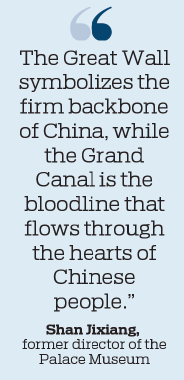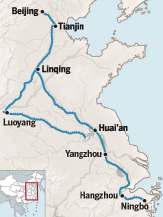Flowing through time
An exhibition reveals how history has navigated the course of the Grand Canal network over the ages, Lin Qi reports.
Editor's note: President Xi Jinping, who is also general secretary of the Communist Party Of China Central Committee, said in 2017 that the Grand Canal is a precious legacy passed down by our ancestors. Culture flows along the waterway, he said, and the watercourse should be protected, inherited and used. In 2019 and 2020, the State Council and various ministries released a series of guidelines to protect and rejuvenate the 2,500-year-old world wonder. China Daily journalists explore the waterway's glorious past, rich legacy and future prospects.
Esteemed 11th-century writer and poet Qin Guan described a serene night in his poem, Han Gou: "Frost brings a chill to Han Gou, and the water looks quite clear; on such a freezing night, a myriad stars light up boats. Deep from the dense water plants come, surprisingly, the sounds of words and the laughter of people."
Han Gou, a canal in today's Jiangsu province, ran across Qin's native city of Gaoyou. It was dredged in the late fifth century BC around a walled city in the state of Wu during the tumultuous Spring and Autumn Period (770-476 BC).
Fuchai, who was then the king of Wu, ordered the construction of Han Gou to connect the Yangtze and Huaihe rivers to the north to facilitate the transportation of soldiers and military supplies.
Han Gou was one of China's earliest known canals and was the precursor to the Grand Canal network.
By the time Qin, who lived in the Northern Song Dynasty (960-1127), wrote the poem, the Grand Canal, which included several artificial waterways that were extensions of Han Gou, had played a strategic role in connecting the country's north and south to ensure political stability, economic prosperity and cultural infusion throughout several dynasties.
The weight of history Qin felt that night at Han Gou continues to touch people today. They appreciate his poem, which is printed on a wall at the National Museum of China in Beijing, which also displays a bronze sword believed to have been used by Fuchai that was unearthed in Anhui province in 1976.
These are being shown at the exhibition, Paddling for A Thousand Miles, until March 1, to hail the storied history of the 3,200-kilometer-long Grand Canal.
The vast conglomeration of artificial waterways-about half of it still functioning today-running through the extensive central-eastern and northern-eastern plains of China was inscribed as a UNESCO World Heritage site in 2014.
Chief curator Zhao Yong says it wasn't easy to organize the show to trace the monumental project's history.
The exhibition presents over 170 artifacts from the collections of the National Museum, the Capital Museum in Beijing, Tianjin Museum, Hebei Museum in Shijiazhuang and several other cultural institutions.
It employs digital technology, such as an animation that simulates the bustling transportation and social life along the waterways.
The displayed objects show how various sections were excavated, what roles these different channels played, how cargo, especially of national importance, such as grain, was guarded and how the construction advanced engineering, shipping management and cultural diversity.
The animation, which is based on a picture book titled China Through Time: A 2,500-Year Journey Along the World's Greatest Canal, published by Encyclopedia of China Publishing House and DK Publishing, is displayed on a three-meter-high and 25-meter-long screen.
Shangguan Tianmeng, the exhibition's chief visual designer, says: "The display tables and platforms are curved to resemble waves. This, along with lighting, creates an atmosphere as if viewers are walking along a waterway as they navigate the Grand Canal's past."
Major extensions
Yang Guang, the Sui Dynasty (581-618) emperor Yangdi, was another key figure in the network's development.
Linking even more expansive areas in the north and south became a main task for Sui rulers, following a long period of political turmoil.
Under Yangdi's command, more canals were dredged to extend the Han Gou waterway system.
The final network reached Zhuojun in today's Beijing to the north and Yuhang in today's Hangzhou in Zhejiang province to the south. It connected China's five major river basins, and enabled the shipment of commodities and the deployment of troops over an extensive area.
A gilt-bronze fushou-a beast-faced door knocker-at the exhibition marks Yangdi's contributions. It was one of four such objects found in his tomb in Yangzhou, Jiangsu, in 2013.
But the megaproject's massive investment contributed to the Sui's downfall.
Meanwhile, the improved canal system prompted economic and cultural exchanges along the Yellow and Yangtze rivers. It laid a foundation for the unification of China in the Tang Dynasty (618-907) and for prosperity throughout the following centuries.
Subsequent dynasties, including the Ming (1368-1644), engaged in major maintenance and small extensions to keep the vast transportation system clean and efficient. The exhibition displays A Panoramic View of the Grand Canal, a Ming-era scroll painting that Zhao hails as "an important item in the National Museum's collection".
"It vividly illustrates canal scenes in green and the Yellow River in yellow. And it pinpoints major water-conservation projects along the waterway, as well as mountains, cities, temples and bridges, to provide both overall and detailed perspectives," Zhao says.
When appreciating this centuries-old silk landscape painting, one can envision a bustling scene at the time when boats loaded with grain from eight provinces along the Grand Canal sailed to Beijing to feed royals, government officials, soldiers and ordinary people.
The Forbidden City
The Grand Canal runs through dozens of cities. But the exhibition sheds light on the particularly close relationship between the canal system and Beijing, the destination of the waterways' expenditure and the imperial city of the Yuan (1271-1368), Ming and Qing (1644-1911) dynasties.
The Grand Canal facilitated the time-consuming journeys of laborers and materials for the construction of the Forbidden City, which marked its 600th anniversary in 2020.
Zhao says the palace complex was built using advanced techniques and craftsmanship from different parts of the country.
"For example, resources like the bricks fired in Linqing, Shandong province, and Suzhou in Jiangsu, and gigantic timber cut in Hunan province were transported to the imperial city along the canal's various sections," he says.
Wei Jihong was a worker at a brickyard in Zhangjiawan, in today's Tongzhou district of Beijing, who oversaw the royal bricks' arrival from the south. His name and responsibility are inscribed on a large block shown at the exhibition.
Wei's workplace was piled high with quality bricks manufactured at official kilns in Jiangsu, Anhui, Henan and Shandong provinces, intended for the Forbidden City's construction.
The cube-shaped blocks fired in Suzhou were deemed "golden bricks "because of their superior quality. Producing a "golden brick" involved complicated techniques and typically took a year, after which it was shipped along the canal to Tongzhou's port.
There, the bricks were unloaded and transported by carriage to the Forbidden City, where they created palace floors.
The Grand Canal should even be credited with the origin of Peking roast duck, which was once an imperial dish.
A short animation played at the exhibition shows that white lake ducks endemic to the south were shipped to Beijing. They were later domesticated to produce Peking roast duck.
According to the animation, large quantities of goods were transported along the canal system after Zhu Di, or Ming emperor Yongle, moved the capital from Nanjing to Beijing. When the cargo boats closed in on Beijing, grain would fall into the water from broken bags. Consequently, the ducks raised in nearby villages were found to possess quality meat.
The preparation method is also believed to have been first mastered by royal-court chefs in Nanjing and later brought to Beijing so Zhu Di could still savor the delicacy. A century later, the recipe moved beyond the imperial city, into the civilian world.
Shan Jixiang, former director of the Palace Museum (Forbidden City), says that because many materials used to build the compound arrived in Beijing via the Grand Canal, ancient Beijing was, in some ways, "formed by and flowed from the canal".
"The Great Wall symbolizes the firm backbone of China, while the Grand Canal is the bloodline that flows through the hearts of Chinese people," he says.
"This artificial waterway that runs across the nation is also a spiritual haven for millions."
Contact the writer at linqi@chinadaily.com.cn

















